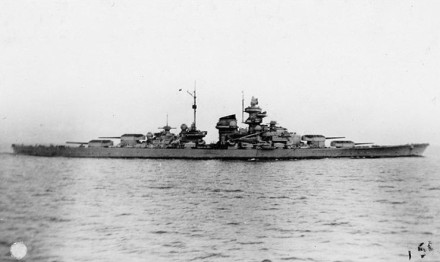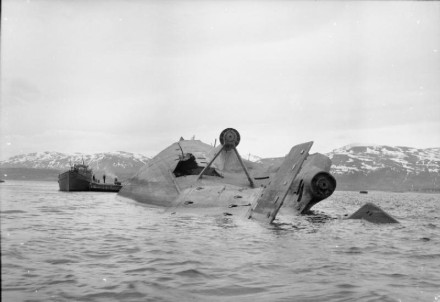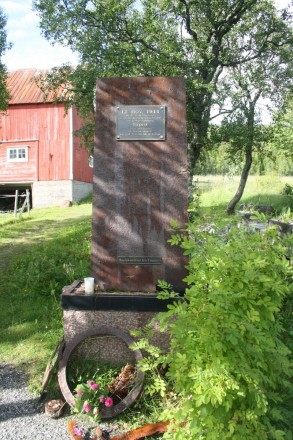History
Heaviest European battleship
The Tirpitz was a battleship from the Bismarck class (the only one in this class asides from the Bismarck). While she was built along the same specifications, a series of wartime adjustments made her 2000 tons heavier than the Bismarck, making her the heaviest battleship ever built by a European navy. It was named after admiral Alfred von Tirpitz, the man who shaped the German Imperial Navy (Kaiserliche Marine).

Wartime service
After commissioning, the Tirpitz first served in the Baltic Sea, to avoid a break-out of the Soviet Baltic Fleet. She was however soon deployed to Norway to deter a possible allied invasion of Northern Europe. While stationed there, her job was also to intercept Allied convoys to the northern Soviet Union. The Tirpitz acted as a fleet in being, exacting a naval force without doing much except for being present with large firepower. The Presence of the Tirpitz in northern waters forced the Royal Navy to have a significant amount of vessels present in the area to keep the Tirpitz from coming into action.
In September 1943, the Tirpitz bombarded Allied positions on Spitsbergen, together with the battleship Scharnhorst. This was the only time the ship used her main battery in an offensive action.
British actions against the Tirpitz
The presence of the Tirpitz was a problem for the allied forces, so the British army launched a number of attacks to get rid of the ship. Late in 1943, the ship was attacked with midget submarines. After this, she was subject to a series of large scale, well planned air raids.
Many of the raids by navy aircraft were not very effective, causing this job to be handed over to the RAF. From a base in Russia, they launched two operations, called Pavane and Obviate, attacking the ship with Lancaster bombers carrying 5.4 ton Tallboy bombs. The first operation, on September 15th, 1944, blew a hole in the bow of the Tirpitz, rendering her unseaworthy and making her slow. The hole was temporarily patched and the ship was moved to the island of Håkøya near Tromsø.

There, the ship was subject to another attack during Operation Obviate on October 29th. This attack was not very succesful, also due to bad weather. One near miss blew a hole in the hull of the ship. After this attack, the ship's anchorage was significantly improved. A large sandbank was constructed under and around the ship to prevent her from capsizing, and anti-torpedo nets were installed.
Operation Catechism
The following attack, called Operation Catechism, followed on November 12th, 1944. The Tirpitz defended herself with her anti aircraft guns, but the 32 RAF bombers were able to drop 29 Tallboys on the ship. There were two direct hits and one near miss, and many of the bombs ended up within the anti-torpedo nets, causing the newly made sandbank to be destroyed. One bomb penetrated the ship's deck but failed to explode. A second bomb hit amidships and blew a very large hole in the ship's side and bottom. A third bomb may have struck the port side.
The amidships hit caused significant flooding and caused the ship to list heavily. An explosion on the ship blew off a gun turret, which flew through the air, crushing a group of men trying to swim to the shore. Then the Tirpitz rapidly rolled over and buried her superstructure in the sea floor.
After the attack, 82 men trapped in the upturned hull were rescued by cutting through the exposed bottom, but the amount of casualties was enormous. Figures for the death toll vary from approximately 950 to 1,204.
Description
Class: Bismarck class
Yard: Kriegsmarinewerft, Wilhelmshaven (Germany, yard number 128)
Propulsion: 12 boilers, 3 BBC steam turbines, 2 shafts
Armament:
8 × 38 cm guns
12 × 15 cm guns
16 × 10,5 cm guns
16 × 3,7 cm guns
12–58 × 2 cm Flak anti-aircraft guns
8 × 53,3 cm torpedo tubes
The keel was laid on November 2nd, 1936, the ship was launched on April 1st, 1939 and commissioned on February 25th, 1941.

| Master | Weber, Robert |
|---|---|
| People on board | 2,500 |
| Power | 163026 hp |
| Speed | 31 knots ~ 36 mph (57 km/h) |
| Length | 832 feet (253.6 m) |
| Width | 118 feet (36 m) |
| Draft | 32 ½ feet (9.9 m) |
| Displacement | 41700 ton |
Status
Salvage work
After her demise, several operations were undertaken to salvage parts and materials from the Tirpitz. This was possible due to the fact that she lay in shallow water, partly sticking out above it. Shortly after her demise, when Germany was still occupying Norway, important parts were salvaged. After the British armed forces entered Norway, they took out everything else that was of military use, after which the ownership of the wreck went over to the Norwegian government. They sold the salvage rights to a salvage company especially founded for this goal called Høvding Skipsopphuggeri. They removed much of the steel and metals between 1948 and 1957, with the help of German experts.

Remembrance
Near her long-term mooring place, a museum dedicated to the Tirpitz was established in a former German barracks building in Kåfjorden. This museum tells the story of the many attacks on the ship. The Tromsø Defence Museum tells the story of the sinking of the Tirpitz. Both museums display a large amount of objects from the ship.
A small memorial stone was placed on a beach on the island of Håkøya, near where the Tirpitz sunk. The remains of the anti-torpedo nets can still be seen in the water.

References
- Bomber Command Museum.
Sinking of the Tirpitz. - Wikimedia Commons.
Operation Catechism. - Nordnorge.com.
Tirpitz played a major role in the war drama in Northern Norway. - Tromsø Defence Museum.
Tromsø Defence Museum.